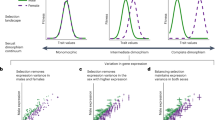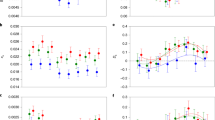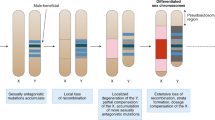Abstract
Females and males often differ extensively in their physical traits. This sexual dimorphism is largely caused by differences in gene expression. Recent advances in genomics, such as RNA sequencing (RNA-seq), have revealed the nature and extent of sex-biased gene expression in diverse species. Here we highlight new findings regarding the causes of sex-biased expression, including sexual antagonism and incomplete dosage compensation. We also discuss how sex-biased expression can accelerate the evolution of sex-linked genes.
This is a preview of subscription content, access via your institution
Access options
Subscribe to this journal
Receive 12 print issues and online access
$189.00 per year
only $15.75 per issue
Buy this article
- Purchase on Springer Link
- Instant access to full article PDF
Prices may be subject to local taxes which are calculated during checkout



Similar content being viewed by others
References
Ellegren, H. & Parsch, J. The evolution of sex-biased genes and sex-biased gene expression. Nature Rev. Genet. 8, 689–698 (2007).
Arnqvist, G. & Rowe, L. Sexual Conflict (Princeton Univ. Press, 2005).
Chippindale, A. K., Gibson, J. R. & Rice, W. R. Negative genetic correlation for adult fitness between sexes reveals ontogenetic conflict in Drosophila. Proc. Natl Acad. Sci. USA 98, 1671–1675 (2001).
Innocetti, P. & Morrow, E. H. The sexually antagonistic genes of Drosophila melanogaster. PLoS Biol. 16, e1000335 (2010).
Connallon, T. & Clark, A. G. Association between sex-biased gene expression and mutations with sex-specific phenotypic consequences in Drosophila. Genome Biol. Evol. 3, 151–155 (2011).
Telonis-Scott, M., Kopp, A., Wayne, M. L., Nuzhdin, S. V. & McIntyre, L. M. Sex-specific splicing in Drosophila: widespread occurrence, tissue specificity and evolutionary conservation. Genetics 181, 421–434 (2009).
Hartmann, B. et al. Distinct regulatory programs establish widespread sex-specific alternative splicing in Drosophila melanogaster. RNA 17, 453–468 (2011).
Gallach, M., Chandrasekaran, C. & Betran, E. Analyses of nuclearly encoded mitochondrial genes suggest gene duplication as a mechanism for resolving intralocus sexually antagonistic conflict in Drosophila. Genome Biol. Evol. 2, 835–850 (2010).
Connallon, T. & Clark, A. G. The resolution of sexual antagonism by gene duplication. Genetics 187, 919–937 (2011).
Gallach, M. & Betrán, E. Intralocus sexual conflict resolved through gene duplication. Trends Ecol. Evol. 26, 222–228 (2011).
Wyman, M. J., Cutter, A. D. & Rowe, L. Gene duplication in the evolution of sexual dimorphism. Evolution 66, 1556–1566 (2012).
Chen, S. et al. Reshaping of global gene expression networks and sex-biased gene expression by integration of a young gene. EMBO J. 31, 2798–2809 (2012).
Cocquet, J. et al. A genetic basis for a postmeiotic X versus Y chromosome intragenomic conflict in the mouse. PLoS Genet. 8, e1002900 (2012).
Parisi, M. et al. Paucity of genes on the D. melanogaster X chromosome showing male-biased expression. Science 299, 697–700 (2003).
Meisel, R. P., Malone, J. H. & Clark, A. G. Disentangling the relationship between sex-biased gene expression and X-linkage. Genome Res. 22, 1255–1265 (2012).
Assis, R., Zhou, Q. & Bachtrog, D. Sex-biased transcriptome evolution in Drosophila. Genome Biol. Evol. 4, 1189–1200 (2012).
Reinius, B. et al. Abundance of female-biased and paucity of male-biased somatically expressed genes on the mouse X-chromosome. BMC Genomics 13, 607 (2012).
Itoh, Y. et al. Dosage compensation is less effective in birds than in mammals. J. Biol. 6, 2 (2007).
Ellegren, H. et al. Faced with inequality: chicken do not have a general dosage compensation of sex-linked genes. BMC Biol. 5, 40 (2007).
Zha, X. et al. Dosage analysis of Z chromosome genes using microarray in silkworm, Bombyx mori. Insect Biochem. Mol. Biol. 39, 315–321 (2009).
Vicoso, B. & Bachtrog, D. Lack of global dosage compensation in Schistosoma mansoni, a female-heterogametic parasite. Genome Biol. Evol. 3, 230–235 (2011).
Kaiser, V. B. & Ellegren, H. Nonrandom distribution of genes with sex-biased expression in the chicken genome. Evolution 60, 1945–1951 (2006).
Arunkumar, K. P., Mita, K. & Nagaraju, J. The silkworm Z chromosome is enriched in testis-specific genes. Genetics 182, 493–501 (2009).
Leder, E. H. et al. Female-biased expression on the X chromosome as a key step in sex chromosome evolution in threespine sticklebacks. Mol. Biol. Evol. 27, 1495–1503 (2010).
Prince, E. G., Kirkland, D. & Demuth, J. P. Hyperexpression of the X chromosome in both sexes results in extensive female bias of X-linked genes in the flour beetle. Genome Biol. Evol. 2, 336–346 (2010).
Gupta, V. et al. Global analysis of X-chromosome dosage compensation. J. Biol. 5, 3 (2006).
Meiklejohn, C. D., Landeen, E. L., Cook, J. M., Kingan, S. B. & Presgraves, D. C. Sex chromosome-specific regulation in the Drosophila male germline but little evidence for chromosomal dosage compensation or meiotic inactivation. PLoS Biol. 9, e1001126 (2011).
Meiklejohn, C. D. & Presgraves, D. C. Little evidence for demasculinization of the Drosophila X chromosome among genes expressed in the male germline. Genome Biol. Evol. 4, 895–904 (2012).
Chang, P. L., Dunham, J. P., Nuzhdin, S. V. & Arbeitman, M. N. Somatic sex-specific transcriptome differences in Drosophila revealed by whole transcriptome sequencing. BMC Genomics 12, 364 (2011).
Catalán, A., Hutter, S. & Parsch, J. Population and sex differences in Drosophila melanogaster brain gene expression. BMC Genomics 13, 654 (2012).
Lemos, B., Araripe, L. O. & Hartl, D. L. Polymorphic Y chromosomes harbor cryptic variation with manifold functional consequences. Science 319, 91–93 (2008).
Lemos, B., Branco, A. T. & Hartl, D. L. Epigenetic effects of polymorphic Y chromosomes modulate chromatin components, immune response, and sexual conflict. Proc. Natl Acad. Sci. USA 107, 15826–15831 (2010).
Kashimada, K. & Koopman, P. Sry: the master switch in mammalian sex determination. Development 137, 3921–3930 (2010).
Mank, J. E., Nam, K., Brunström, B. & Ellegren, H. Ontogenetic complexity of sexual dimorphism and sex-specific selection. Mol. Biol. Evol. 27, 1570–1578 (2010).
Baker, D. A. et al. A comprehensive gene expression atlas of sex- and tissue-specificity in the malaria vector, Anopheles gambiae. BMC Genomics 12, 296 (2011).
Haerty, W. et al. Evolution in the fast lane: rapidly evolving sex-related genes in Drosophila. Genetics 177, 1321–1335 (2007).
Demuth, J. P. & Wade, M. J. Maternal expression increases the rate of bicoid evolution by relaxing selective constraint. Genetica 129, 37–43 (2007).
Meisel, R. P. Towards a more nuanced understanding of the relationship between sex-biased gene expression and rates of protein-coding sequence evolution. Mol. Biol. Evol. 28, 1893–1900 (2011).
Grath, S. & Parsch, J. Rate of amino acid substitution is influenced by the degree and conservation of male-biased transcription over 50 myr of Drosophila evolution. Genome Biol. Evol. 4, 346–359 (2012).
Swanson, W. J. & Vacquier, V. D. The rapid evolution of reproductive proteins. Nature Rev. Genet. 3, 137–144 (2002).
Charlesworth, B., Coyne, J. A. & Barton, N. H. The relative rates of evolution of sex chromosomes and autosomes. Am. Nat. 130, 113–146 (1987).
Orr, H. A. & Betancourt, A. J. Haldane's sieve and adaptation from the standing genetic variation. Genetics 157, 875–884 (2001).
Vicoso, B. & Charlesworth, B. Effective population size and the faster-X effect, an extended model. Evolution 63, 2413–2426 (2009).
Baines, J. F., Sawyer, S. A., Hartl, D. L. & Parsch, J. Effects of X-linkage and sex-biased gene expression on the rate of adaptive protein evolution in Drosophila. Mol. Biol. Evol. 25, 1639–1650 (2008).
Sella, G., Petrov, D. A., Przeworski, M. & Andolfatto, P. Pervasive natural selection in the Drosophila genome? PLoS Genet. 5, e1000495 (2009).
Eyre-Walker, A. & Keightley, P. D. Estimating the rate of adaptive molecular evolution in the presence of slightly deleterious mutations and population size change. Mol. Biol. Evol. 26, 2097–2108 (2009).
Wilson, D. J., Hernandez, R. D., Andolfatto, P. & Przeworski, M. A population genetics-phylogenetics approach to inferring natural selection in coding sequences. PLoS Genet. 7, e1002395 (2011).
Mank, J. E., Axelsson, E. & Ellegren, H. Fast-X on the Z: rapid evolution of sex-linked genes in birds. Genome Res. 17, 618–624 (2007).
Mank, J. E., Nam, K. & Ellegren, H. Faster-Z evolution is predominantly due to genetic drift. Mol. Biol. Evol. 27, 661–670 (2010).
Mank, J. E., Vicoso, B., Berlin, S. & Charlesworth, B. Effective population size and the faster-X effect, empirical results and their interpretation. Evolution 64, 663–674 (2010).
Llopart, A. The rapid evolution of X-linked male-biased gene expression and the large-X effect in Drosophila yakuba, D. santomea, and their hybrids. Mol. Biol. Evol. 29, 3873–3886 (2012).
Meisel, R. P., Malone, J. H. & Clark, A. G. Faster-X evolution of gene expression in Drosophila. PLoS Genet. 8, e1003013 (2012).
Gnad, F. & Parsch, J. Sebida: a database for the functional and evolutionary analysis of genes with sex-biased expression. Bioinformatics 22, 2577–2579 (2006).
Acknowledgements
The authors wish to acknowledge funding (to J.P.) from the Deutsche Forschungsgemeinschaft, and (to H.E.) from the European Research Council, the Knut and Alice Wallenberg Foundation and the Swedish Research Council.
Author information
Authors and Affiliations
Ethics declarations
Competing interests
The authors declare no competing financial interests.
Related links
Glossary
- Cis-regulatory changes
-
Changes in gene regulatory sequences, such as promoters and enhancers, that alter the expression of genes located nearby on the same chromosome.
- Effective population size
-
(Ne). An idealized description of the number of breeding individuals in a population over many generations. Ne is usually much smaller than the current census population size. As Ne increases, the influence of natural selection becomes greater, whereas the influence of genetic drift is diminished.
- Genetic drift
-
Stochastic variation in allele frequency in a population across generations. The effect of genetic drift is more pronounced when the effective population size is small.
- Pleiotropy
-
The situation in which a single gene influences multiple phenotypic traits. This places more constraint on the gene and can reduce its rate of evolution.
- Purifying selection
-
Negative selection against deleterious mutations. This is thought to be the most prevalent form of natural selection.
- Retroduplication
-
A mechanism that creates duplicate gene copies in new genomic positions through the reverse transcription of mRNAs from source genes (also known as retroposition).
- Sexual antagonism
-
Conflict arising from traits that are beneficial to one sex but harmful to the other.
- Slightly deleterious mutations
-
Mutations with a very small negative effect on fitness. When effective population size is low, their probability of fixation is mainly governed by stochastic events.
- Standing variation
-
Existing genetic variation that is the result of past mutations that have become neither lost nor fixed in a population.
- Trans-regulatory changes
-
Sequence changes that alter the expression of genes located on different chromosomes or far away on the same chromosome.
Rights and permissions
About this article
Cite this article
Parsch, J., Ellegren, H. The evolutionary causes and consequences of sex-biased gene expression. Nat Rev Genet 14, 83–87 (2013). https://doi.org/10.1038/nrg3376
Published:
Issue Date:
DOI: https://doi.org/10.1038/nrg3376
This article is cited by
-
Correlation scan: identifying genomic regions that affect genetic correlations applied to fertility traits
BMC Genomics (2022)
-
Selection drives convergent gene expression changes during transitions to co-sexuality in haploid sexual systems
Nature Ecology & Evolution (2022)
-
Evolution of sexual systems, sex chromosomes and sex-linked gene transcription in flatworms and roundworms
Nature Communications (2022)
-
Sex determination mechanisms and sex control approaches in aquaculture animals
Science China Life Sciences (2022)
-
Sex differences in immune gene expression in the brain of a small shorebird
Immunogenetics (2022)



